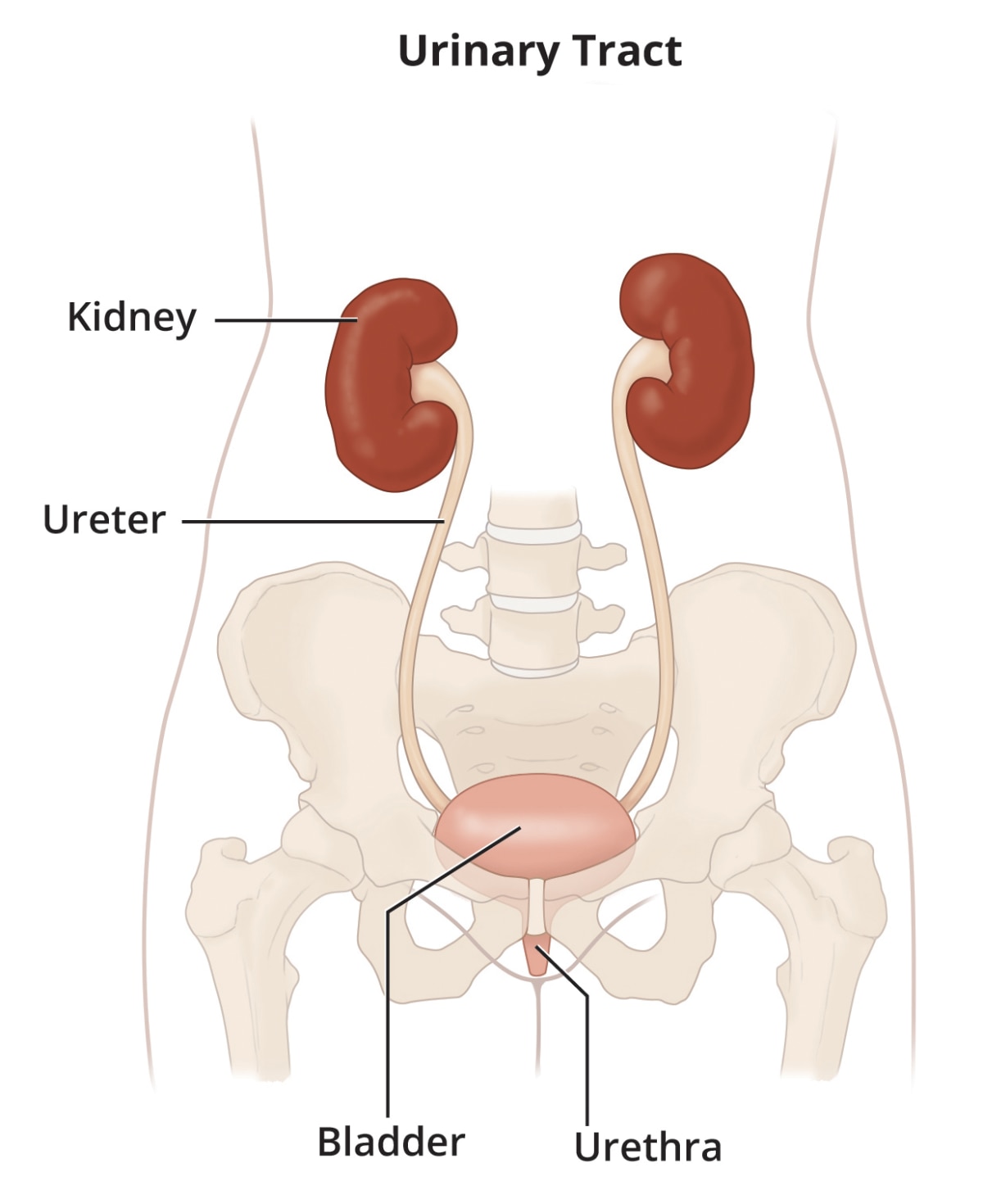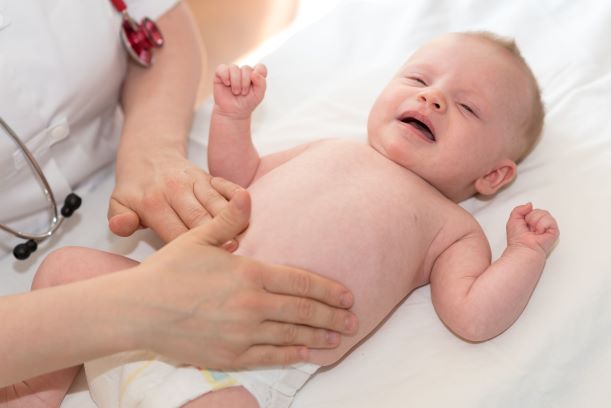Is It Normal for Unborn Babies to Have Fluid in Kidneys of Unborn Baby
On this page:
- What is hydronephrosis in newborns?
- Does hydronephrosis have other names?
- How mutual is hydronephrosis in newborns?
- Who is more likely to take hydronephrosis?
- Is hydronephrosis a sign of a problem?
- What are the signs or symptoms of hydronephrosis in a newborn?
- What causes hydronephrosis in newborns?
- How exercise health care professionals diagnose hydronephrosis before an babe is born?
- How practise health care professionals diagnose hydronephrosis in newborns?
- How do health care professionals treat hydronephrosis in newborns?
- Clinical Trials for Hydronephrosis in Newborns
What is hydronephrosis in newborns?
Hydronephrosis in newborns is enlargement, or dilation, of the renal pelvis—the basin in the central part of the kidney where urine collects. Hydronephrosis can occur in one or both kidneys. This condition is frequently diagnosed before birth during a prenatal ultrasound.
In some cases, hydronephrosis is mild and goes abroad on its ain without treatment. In other cases, hydronephrosis may be a sign of a blockage in the urinary tract or reflux—or support—of urine from the bladder to the kidney that needs treatment.
The urinary tract is the body's drainage system for removing wastes and actress fluid. The urinary tract includes the kidneys, ureters, bladder, and urethra.

Does hydronephrosis have other names?
Hydronephrosis may be called other names, including
- antenatal, fetal, or prenatal hydronephrosis, when the condition is diagnosed before birth
- dilated or enlarged urinary tract
How common is hydronephrosis in newborns?
In 1 or 2 out of every 100 pregnancies, the fetus is diagnosed with hydronephrosis.1 In nigh one-half of these cases, the hydronephrosis goes away past the time the babe is born.2
Who is more probable to have hydronephrosis?
Males are virtually twice as probable as females to accept hydronephrosis.3
Is hydronephrosis a sign of a problem?
If a fetus or newborn is found to accept hydronephrosis, health care professionals volition begin to examine how urine drains from the kidneys. The more severe hydronephrosis is, the more than likely information technology is to be a sign of a blockage in the urinary tract or reflux of urine from the float to the kidney, which may demand treatment. Early diagnosis and treatment of the blockage or reflux may help prevent complications or forestall complications from getting worse.
Commonly, the fetus's urine becomes part of the amniotic fluid that surrounds the fetus in the womb. In a fetus with severe hydronephrosis, too much urine may stay in the urinary tract, leading to low levels of amniotic fluid in the womb. Low levels of amniotic fluid tin can harm the fetus's developing lungs.
Later on an infant is born, hydronephrosis may atomic number 82 to complications such every bit urinary tract infections, kidney stones, and chronic kidney disease.
What are the signs or symptoms of hydronephrosis in a newborn?
Newborns with hydronephrosis often practice not show signs. In some newborns, the belly may exist bloated due to severe blockage of the urinary tract. In other cases, newborns with hydronephrosis may develop a urinary tract infection, which may crusade signs or symptoms.
If your child has been diagnosed with hydronephrosis, talk with your kid's wellness care professional nigh appropriate evaluation and treatment options.
What causes hydronephrosis in newborns?
In some fetuses and newborns with hydronephrosis, wellness care professionals tin can't detect a cause, and the hydronephrosis goes abroad on its own. This is called transient hydronephrosis.
In other cases, hydronephrosis is caused by a blockage in the urinary tract or reflux of urine from the bladder to the kidney.
Transient hydronephrosis
Experts think that narrowing of part of the urinary tract during early development may cause transient hydronephrosis. The condition resolves as the urinary tract matures.
Near half of fetuses diagnosed with hydronephrosis have transient hydronephrosis, and the condition goes abroad before the infant is born. In children who are born with hydronephrosis, the condition is sometimes transient and can go away on its ain, usually by the time the kid is age 3.2
Birth defects
Nascency defects in the urinary tract may crusade hydronephrosis. Even when nativity defects are the crusade, hydronephrosis may be mild and may improve every bit the child gets older. However, birth defects may as well cause hydronephrosis that is severe or gets worse over time.
Ureter defects. Nascence defects in the ureter that cause hydronephrosis include
- ureteropelvic junction (UPJ) obstruction, in which a blockage is present where the ureter joins the renal pelvis
- vesicoureteral reflux (VUR), in which urine flows backward, or refluxes, from the bladder to one or both ureters and sometimes to the kidneys
- other defects of the ureter or where the ureter joins the bladder, which may forbid the normal catamenia of urine from the kidneys to the bladder
Amid all birth defects that cause hydronephrosis in fetuses and newborns, UPJ obstruction and VUR are well-nigh common.ane
Lower urinary tract obstruction. In lower urinary tract obstacle, also chosen bladder outlet obstruction, a blockage is nowadays in the urethra or where the bladder joins the urethra. Nativity defects that cause lower urinary tract obstruction include posterior urethral valves, which are abnormal folds of tissue that block the urethra. Posterior urethral valves only occur in males. Because lower urinary tract obstruction blocks urine flow from both kidneys, information technology is more than urgent for doctors to examine lower urinary tract obstruction than blockage or reflux in a ureter.
Defects in the urinary tract and other parts of the body. Some infants with hydronephrosis have nativity defects in the urinary tract and in other parts of their trunk. For example, prune abdomen syndrome is a group of birth defects that includes poorly developed abdominal muscles, undescended testicles, and urinary tract defects.
Birth defects that bear upon the spinal string, such equally spina bifida, tin can affect the nerves that control the urinary tract and cause urinary retentiveness. Urine retained in the bladder may flow backward into the ureters and kidneys, causing hydronephrosis.
How do health care professionals diagnose hydronephrosis before an babe is born?
Health care professionals can diagnose hydronephrosis earlier an infant is built-in during a prenatal ultrasound. Ultrasound bounces safe, painless sound waves off the fetus's organs to create an image of their structure. An ultrasound can evidence that parts of the urinary tract are enlarged due to hydronephrosis.
Ultrasounds during pregnancy are role of routine prenatal testing. If a fetus is diagnosed with hydronephrosis, health care professionals may recommend additional ultrasounds to discover out if hydronephrosis gets worse or improves over time. Health intendance professionals may besides utilise ultrasounds or other prenatal tests to endeavor to find the crusade of hydronephrosis or check for other health issues.
How practise health care professionals diagnose hydronephrosis in newborns?
Health intendance professionals employ a newborn'due south medical history, a physical exam, and imaging tests to diagnose hydronephrosis.
Medical history
Wellness care professionals use the results of prenatal ultrasounds and other prenatal tests to determine what kind of testing or treatment infants will need after birth.
Physical exam
During a physical exam, a health intendance professional will check for a lump or mass in the abdomen, which could be a sign of an enlarged kidney or float. A health care professional will also check for signs of birth defects in other parts of the body.
Imaging tests
Health care professionals may apply urinary tract imaging tests to diagnose and find the cause of hydronephrosis. Imaging tests may include
- ultrasound, which uses sound waves to view the child'southward urinary tract
- voiding cystourethrogram, which uses x-rays to evidence how urine flows through the float and urethra
- radionuclide browse, which creates images of the urinary tract equally a radioactive substance passes through
How practise health care professionals treat hydronephrosis in newborns?
Treatment of hydronephrosis in newborns will depend on
- how severe the condition is
- whether 1 or both kidneys are afflicted
- what is causing the hydronephrosis
Treatments may include watchful waiting, preventing and treating urinary tract infections, and surgery.
Watchful waiting
If hydronephrosis in a newborn is non severe and non likely to harm the kidneys, health care professionals may recommend watchful waiting. Wellness intendance professionals volition perform tests from time to time to see if hydronephrosis changes or causes kidney damage as the baby gets older.
Hydronephrosis may ameliorate or get abroad over time. Still, if hydronephrosis gets worse or causes complications, a health care professional may recommend surgery.

Preventing and treating urinary tract infections
In some cases, health intendance professionals may prescribe antibiotics to help prevent urinary tract infections in infants and children with hydronephrosis. If a child develops a urinary tract infection, antibiotics are also used to treat the infection.
Inquiry suggests that, in male infants with hydronephrosis, circumcision may lower the take a chance of getting urinary tract infections.4
Surgery
If hydronephrosis is severe or gets worse over time, wellness intendance professionals may recommend surgery. Surgery can ameliorate the flow of urine and lower the risk of complications or keep complications from getting worse.
Health care professionals rarely perform surgery to care for hydronephrosis in a fetus while it'south withal in the womb. Fetal surgery carries many risks, so it is performed merely in special cases.
Clinical Trials for Hydronephrosis in Newborns
The NIDDK conducts and supports clinical trials in many diseases and conditions, including urologic diseases. The trials expect to discover new ways to prevent, detect, or treat affliction and meliorate quality of life.
What are clinical trials and what role do children play in research?
Clinical trials are enquiry studies involving people of all ages. Clinical trials look at condom and constructive new ways to prevent, detect, or treat affliction. Researchers also utilise clinical trials to await at other aspects of care, such every bit improving quality of life. Research involving children helps scientists
- identify care that is all-time for a child
- find the all-time dose of medicines
- find treatments for weather condition that merely affect children
- care for conditions that behave differently in children
- understand how handling affects a growing child's trunk
Discover out more virtually clinical trials and children.
What clinical trials are open up?
Clinical trials that are currently open and are recruiting can exist viewed at
www.ClinicalTrials.gov.
References
Source: https://www.niddk.nih.gov/health-information/urologic-diseases/hydronephrosis-newborns
0 Response to "Is It Normal for Unborn Babies to Have Fluid in Kidneys of Unborn Baby"
Post a Comment